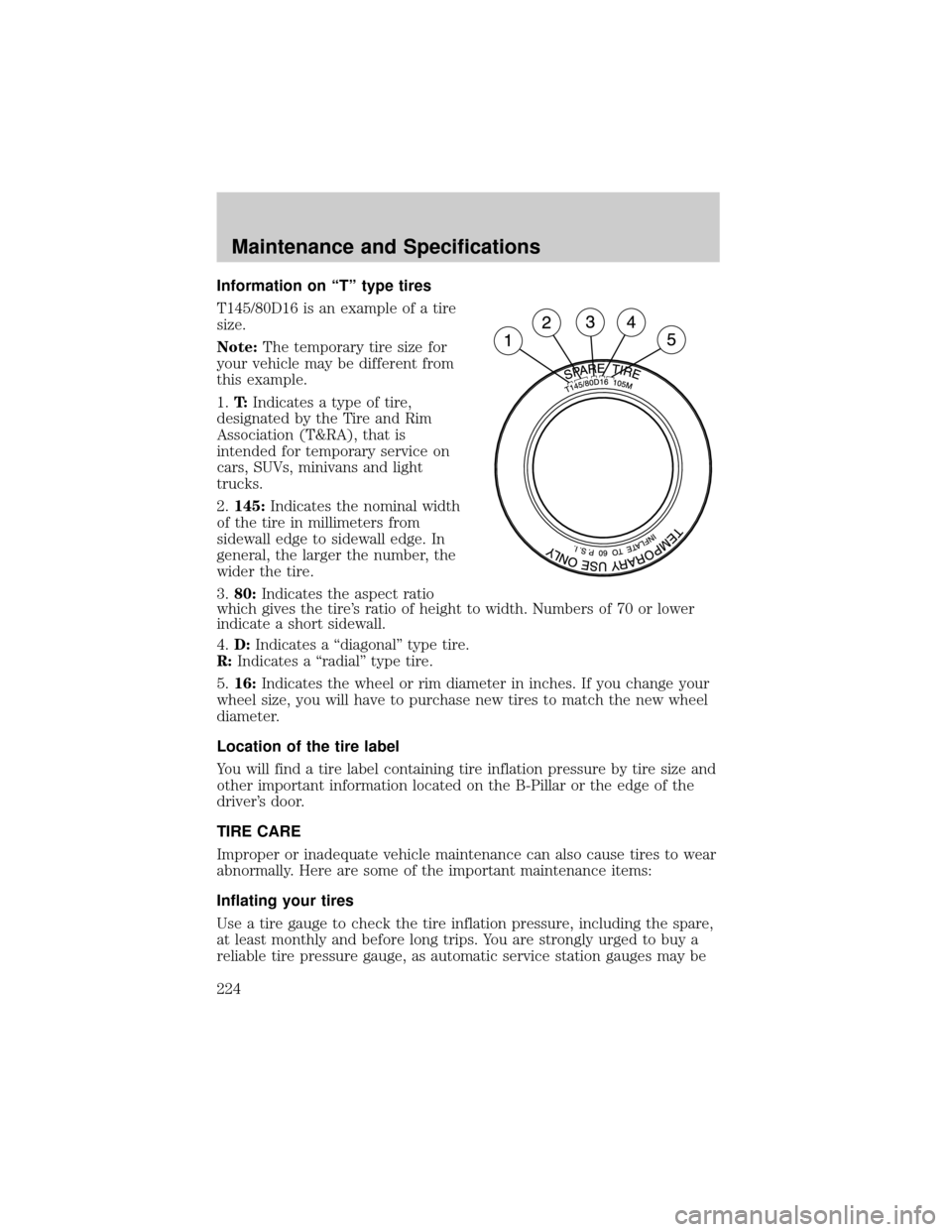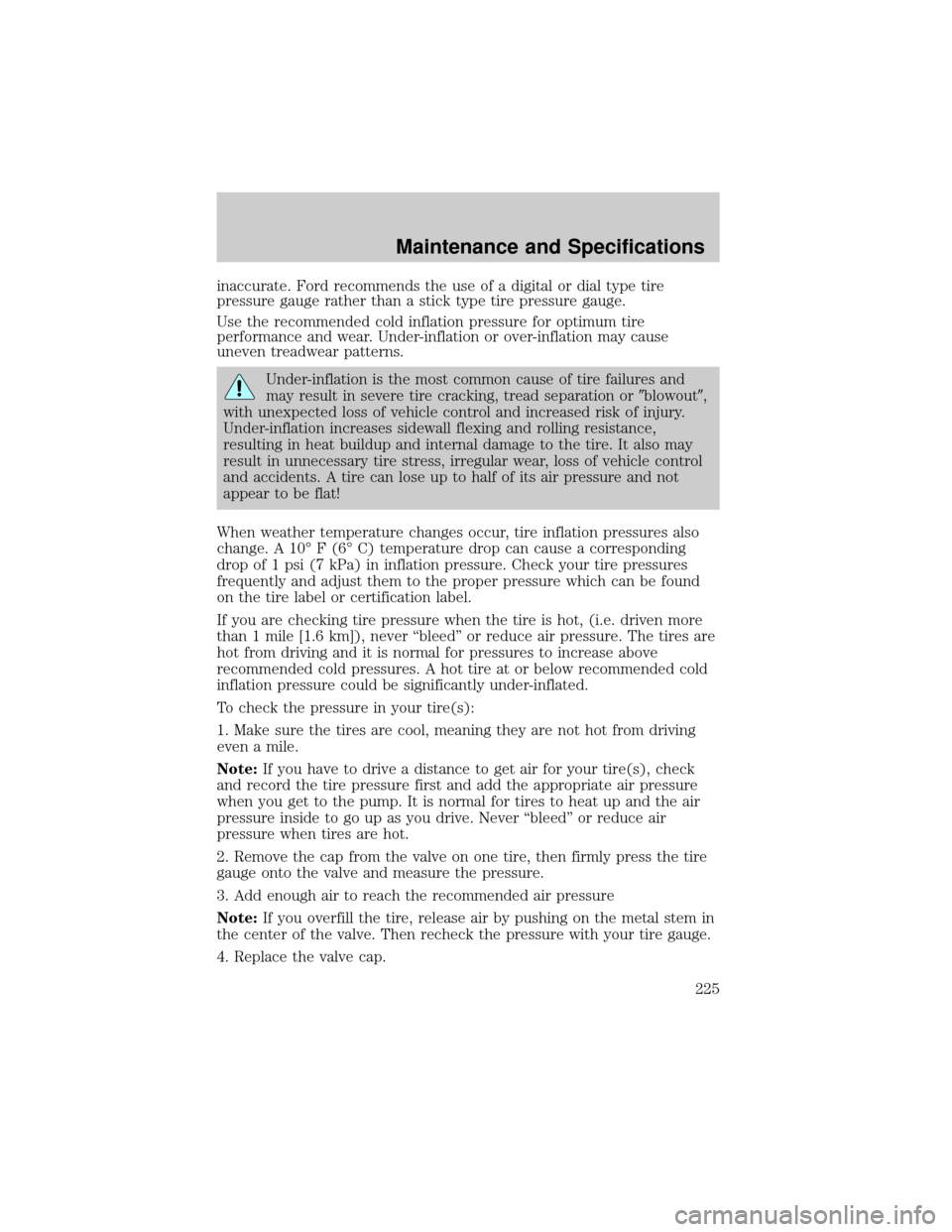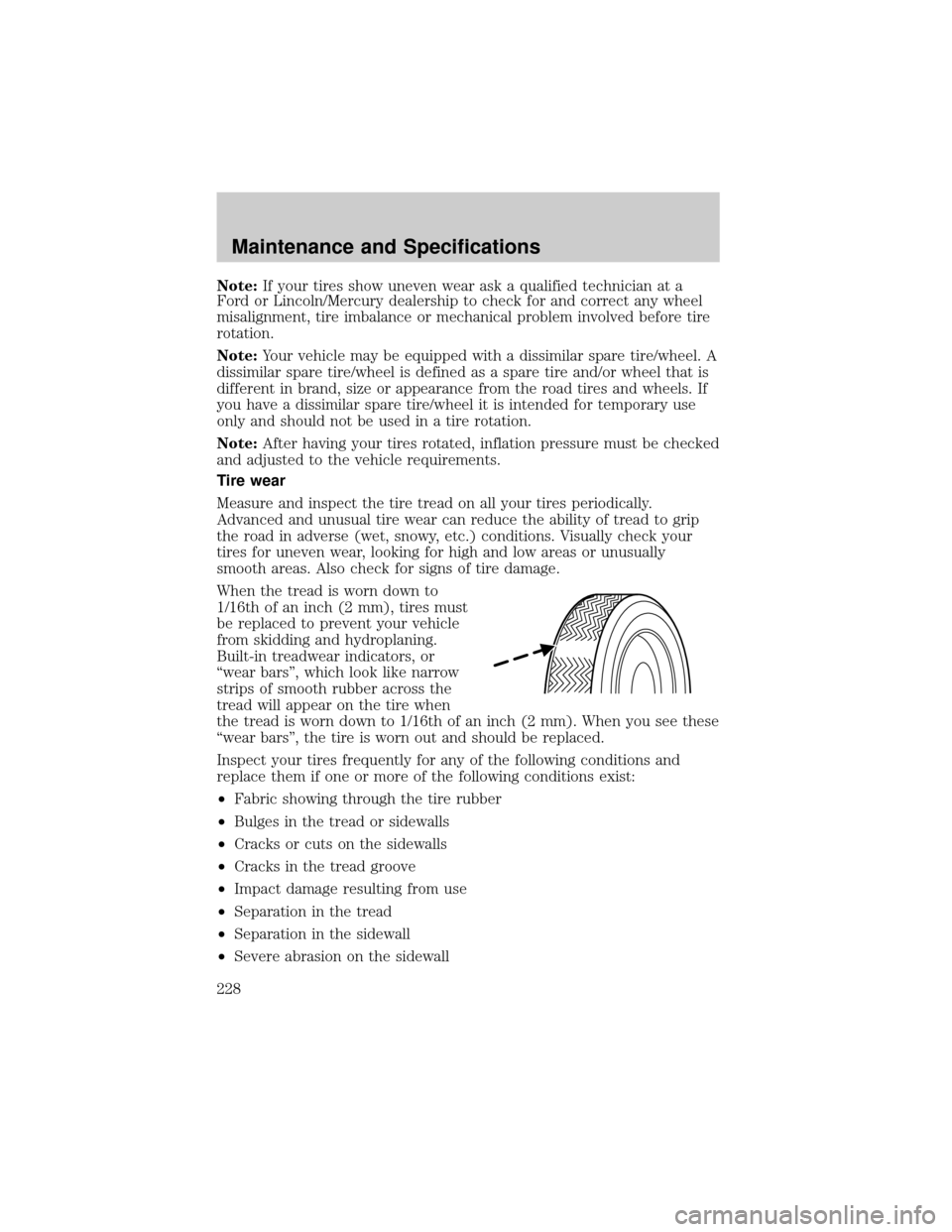2005 FORD TAURUS tire pressure
[x] Cancel search: tire pressurePage 224 of 248

Information on ªTº type tires
T145/80D16 is an example of a tire
size.
Note:The temporary tire size for
your vehicle may be different from
this example.
1.T:Indicates a type of tire,
designated by the Tire and Rim
Association (T&RA), that is
intended for temporary service on
cars, SUVs, minivans and light
trucks.
2.145:Indicates the nominal width
of the tire in millimeters from
sidewall edge to sidewall edge. In
general, the larger the number, the
wider the tire.
3.80:Indicates the aspect ratio
which gives the tire's ratio of height to width. Numbers of 70 or lower
indicate a short sidewall.
4.D:Indicates a ªdiagonalº type tire.
R:Indicates a ªradialº type tire.
5.16:Indicates the wheel or rim diameter in inches. If you change your
wheel size, you will have to purchase new tires to match the new wheel
diameter.
Location of the tire label
You will find a tire label containing tire inflation pressure by tire size and
other important information located on the B-Pillar or the edge of the
driver's door.
TIRE CARE
Improper or inadequate vehicle maintenance can also cause tires to wear
abnormally. Here are some of the important maintenance items:
Inflating your tires
Use a tire gauge to check the tire inflation pressure, including the spare,
at least monthly and before long trips. You are strongly urged to buy a
reliable tire pressure gauge, as automatic service station gauges may be
Maintenance and Specifications
224
Page 225 of 248

inaccurate. Ford recommends the use of a digital or dial type tire
pressure gauge rather than a stick type tire pressure gauge.
Use the recommended cold inflation pressure for optimum tire
performance and wear. Under-inflation or over-inflation may cause
uneven treadwear patterns.
Under-inflation is the most common cause of tire failures and
may result in severe tire cracking, tread separation or9blowout9,
with unexpected loss of vehicle control and increased risk of injury.
Under-inflation increases sidewall flexing and rolling resistance,
resulting in heat buildup and internal damage to the tire. It also may
result in unnecessary tire stress, irregular wear, loss of vehicle control
and accidents. A tire can lose up to half of its air pressure and not
appear to be flat!
When weather temperature changes occur, tire inflation pressures also
change. A 10É F (6É C) temperature drop can cause a corresponding
drop of 1 psi (7 kPa) in inflation pressure. Check your tire pressures
frequently and adjust them to the proper pressure which can be found
on the tire label or certification label.
If you are checking tire pressure when the tire is hot, (i.e. driven more
than 1 mile [1.6 km]), never ªbleedº or reduce air pressure. The tires are
hot from driving and it is normal for pressures to increase above
recommended cold pressures. A hot tire at or below recommended cold
inflation pressure could be significantly under-inflated.
To check the pressure in your tire(s):
1. Make sure the tires are cool, meaning they are not hot from driving
even a mile.
Note:If you have to drive a distance to get air for your tire(s), check
and record the tire pressure first and add the appropriate air pressure
when you get to the pump. It is normal for tires to heat up and the air
pressure inside to go up as you drive. Never ªbleedº or reduce air
pressure when tires are hot.
2. Remove the cap from the valve on one tire, then firmly press the tire
gauge onto the valve and measure the pressure.
3. Add enough air to reach the recommended air pressure
Note:If you overfill the tire, release air by pushing on the metal stem in
the center of the valve. Then recheck the pressure with your tire gauge.
4. Replace the valve cap.
Maintenance and Specifications
225
Page 226 of 248

5. Repeat this procedure for each tire, including the spare.
Note:Some spare tires require higher inflation pressure than the other
tires. Check the tire label on the B pillar or the edge of the driver's door
for the recommended spare tire pressure.
6. Visually inspect the tires to make sure there are no nails or other
objects embedded that could poke a hole in the tire and cause an air
leak.
7. Check the sidewalls to make sure there are no gouges, cuts or bulges.
Tire and wheel alignment
A bad jolt from hitting a curb or pothole can cause the front end of your
vehicle to become misaligned or cause damage to your tires. If your
vehicle seems to pull to one side when you're driving, the wheels may be
out of alignment. Have a qualified technician at a Ford or
Lincoln/Mercury dealer check the wheel alignment periodically.
Wheel misalignment in the front or the rear can cause uneven and rapid
treadwear of your tires and should be corrected by a qualified technician
at a Ford or Lincoln/Mercury dealer. Front wheel drive (FWD) vehicles
and those with an independent rear suspension require alignment of all
four wheels.
The tires should also be balanced periodically. An unbalanced tire and
wheel assembly may result in irregular tire wear.
Tire rotation
Rotating your tires at the recommended interval (as indicated in the
Scheduled Maintenance Guidethat comes with your vehicle) will help
your tires wear more evenly, providing better tire performance and
longer tire life. Unless otherwise specified, rotate the tires approximately
every 5,000 miles (8,000 km).
Maintenance and Specifications
226
Page 228 of 248

Note:If your tires show uneven wear ask a qualified technician at a
Ford or Lincoln/Mercury dealership to check for and correct any wheel
misalignment, tire imbalance or mechanical problem involved before tire
rotation.
Note:Your vehicle may be equipped with a dissimilar spare tire/wheel. A
dissimilar spare tire/wheel is defined as a spare tire and/or wheel that is
different in brand, size or appearance from the road tires and wheels. If
you have a dissimilar spare tire/wheel it is intended for temporary use
only and should not be used in a tire rotation.
Note:After having your tires rotated, inflation pressure must be checked
and adjusted to the vehicle requirements.
Tire wear
Measure and inspect the tire tread on all your tires periodically.
Advanced and unusual tire wear can reduce the ability of tread to grip
the road in adverse (wet, snowy, etc.) conditions. Visually check your
tires for uneven wear, looking for high and low areas or unusually
smooth areas. Also check for signs of tire damage.
When the tread is worn down to
1/16th of an inch (2 mm), tires must
be replaced to prevent your vehicle
from skidding and hydroplaning.
Built-in treadwear indicators, or
ªwear barsº, which look like narrow
strips of smooth rubber across the
tread will appear on the tire when
the tread is worn down to 1/16th of an inch (2 mm). When you see these
ªwear barsº, the tire is worn out and should be replaced.
Inspect your tires frequently for any of the following conditions and
replace them if one or more of the following conditions exist:
²Fabric showing through the tire rubber
²Bulges in the tread or sidewalls
²Cracks or cuts on the sidewalls
²Cracks in the tread groove
²Impact damage resulting from use
²Separation in the tread
²Separation in the sidewall
²Severe abrasion on the sidewall
Maintenance and Specifications
228
Page 247 of 248

Remote entry system
illuminated entry ......................79
locking/unlocking doors ...........73
opening the trunk .....................77
Roadside assistance ..................150
Roof rack .....................................72
S
Safety Belt Maintenance ..........107
Safety belts (see
Safety restraints) ....92, 95±98, 100
Safety defects, reporting ..........180
Safety restraints ............92, 95±101
belt minder .............................103
extension assembly ................107
for adults .............................96±98
for children .....................117±118
lap belt ....................................100
Occupant Classification
Sensor ........................................93
safety belt maintenance .........107
warning light and
chime ...............................102±103
Safety seats for children ..........120
Seat belts (see
Safety restraints) ........................92
Seats ............................................88
child safety seats ....................120
front seats .................................89
Servicing your vehicle ..............187
Setting the clock
AM/FM stereo ...........................15
AM/FM/CD .................................19
AM/FM/Tape ..............................16
Spare tire (see
Changing the Tire) ...................159Spark plugs,
specifications .............231, 235±236
Specification chart,
lubricants ...........................234±235
Speed control ..............................51
Starting a flex fuel vehicle .......133
Starting your
vehicle ........................130±131, 133
jump starting ..........................165
Steering wheel
tilting .........................................47
T
Tilt steering wheel ......................47
Tires ...........................159, 218±219
alignment ................................226
care ..........................................224
changing ..........................159, 161
checking the pressure ............224
label .........................................224
replacing ..................................229
rotating ....................................226
safety practices .......................229
sidewall information ...............220
snow tires and chains ............230
spare tire .................................160
terminology .............................219
tire grades ...............................219
treadwear ........................218, 228
Towing .......................................146
recreational towing .................148
trailer towing ..........................146
wrecker ....................................170
Traction control ........................136
Transaxle
fluid, refill capacities ..............232
lubricant specifications ..........235
Transmission .............................138
Index
247